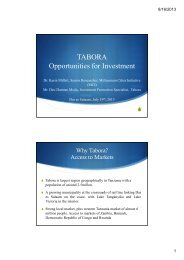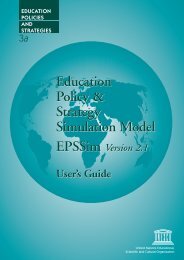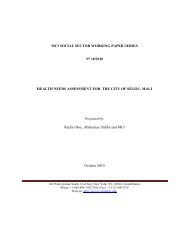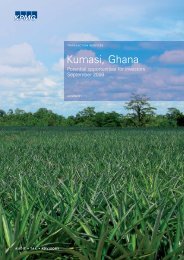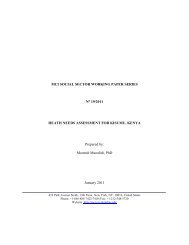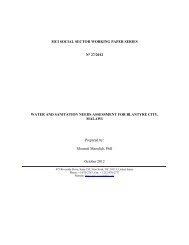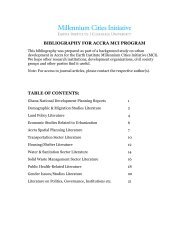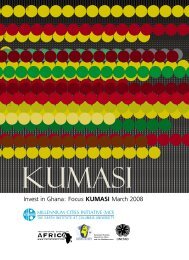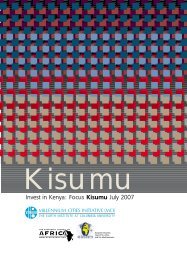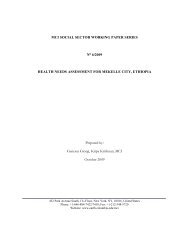Foreign Direct Investment in Blantyre, Malawi - Millennium Cities ...
Foreign Direct Investment in Blantyre, Malawi - Millennium Cities ...
Foreign Direct Investment in Blantyre, Malawi - Millennium Cities ...
Create successful ePaper yourself
Turn your PDF publications into a flip-book with our unique Google optimized e-Paper software.
Coffee is produced <strong>in</strong> more than fifty countries <strong>in</strong> the world. Three countries—Brazil, Colombia, and<br />
Vietnam—account for almost 60 percent of world production. <strong>Malawi</strong> is a m<strong>in</strong>or producer <strong>in</strong> the world<br />
coffee market, produc<strong>in</strong>g less than 0.02 percent of total world production. However, coffee is still a<br />
significant foreign-exchange earner for the country. Production has been decl<strong>in</strong><strong>in</strong>g for a number of years<br />
due to a comb<strong>in</strong>ation of world and local factors, <strong>in</strong>clud<strong>in</strong>g unpredictable market prices of coffee,<br />
escalat<strong>in</strong>g <strong>in</strong>put costs and frequent droughts. 181<br />
Production<br />
<strong>Malawi</strong> coffee is 100 percent Arabica, which usually grows at an elevation above 950 meters. Coffee is<br />
grown ma<strong>in</strong>ly <strong>in</strong> the north and <strong>in</strong> the southeast of the country, with little production <strong>in</strong> the central region.<br />
In the south, coffee is grown only by commercial farms/estates (no smallholder production) and is ma<strong>in</strong>ly<br />
centered around Thyolo (30 miles from <strong>Blantyre</strong>) and Zomba (38 miles from <strong>Blantyre</strong>). In the north,<br />
coffee is predom<strong>in</strong>ately grown by smallholder farmers <strong>in</strong> associations affiliated with the Mzuzu<br />
Smallholder Coffee Farmers Trust (SCFT) and by two small farms around Mzuzu. The profile of the<br />
182<br />
coffee sector is therefore completely different between the north and south.<br />
Value cha<strong>in</strong><br />
Farmer Organizations<br />
There are two ma<strong>in</strong> categories of coffee growers <strong>in</strong> <strong>Malawi</strong>: commercial farms/estates, and smallholder<br />
farmers. In <strong>Malawi</strong> there are currently fifteen active organizations that grow coffee: fourteen commercial<br />
farms/estates and the Mzuzu Trust, which is comprised of five associations of smallholders. Three<br />
growers/processors—Sable, Makandi, and Mzuzu SCFT—account for more than 75 percent of the<br />
estimated production <strong>in</strong> 2006. 183<br />
S<strong>in</strong>ce 2007, the Coffee Association of <strong>Malawi</strong> (CAMAL) has managed to attract buyers from Switzerland,<br />
the US, Canada, and Japan. To push for <strong>in</strong>creased market awareness of the superior quality of <strong>Malawi</strong>’s<br />
coffee, CAMAL has jo<strong>in</strong>ed forces with MIPA, the United Nations Development Program’s Grow<strong>in</strong>g<br />
Susta<strong>in</strong>able Bus<strong>in</strong>ess (GSB) program, and the United States Agency for International Development<br />
184<br />
(USAID).<br />
Opportunity<br />
To boost production, the Government has privatized the Smallholder Coffee Trust <strong>in</strong> Mzuzu, which<br />
empowers smallholder farmers to control coffee production. Thus, opportunities for <strong>in</strong>vestment exist <strong>in</strong><br />
the form of jo<strong>in</strong>t ventures with organizations engaged <strong>in</strong> the production and process<strong>in</strong>g of coffee. 185<br />
Increas<strong>in</strong>g consumption of higher-priced specialty coffee worldwide provides opportunities to growers<br />
will<strong>in</strong>g to <strong>in</strong>vest <strong>in</strong> their coffee crop. Although <strong>Malawi</strong> has some very good grades of coffee, not all of<br />
186<br />
them qualify as specialty grade, which relegates the sale of crops to the bulk ma<strong>in</strong>stream market. This<br />
strategic choice depends to a considerable extent on each producer and their will<strong>in</strong>gness to seek specialty<br />
sale and to make the required <strong>in</strong>vestment.<br />
181<br />
USAID (November 2006). Credit Demand and Supply Study of <strong>Malawi</strong>’s Coffee Sector.<br />
182<br />
Ibid.<br />
183<br />
Semu-Banda, Pilirani (November 21, 2007). TRADE-MALAWI: Coffee Industry Gets Brew<strong>in</strong>g Aga<strong>in</strong>, IPS News.<br />
http://www.ipsnews.net/news.asp?idnews=40149.<br />
184<br />
Ibid.<br />
185<br />
<strong>Malawi</strong> Confederation of Chamber of Commerce and Industry (2008). Agricultural Sector Bus<strong>in</strong>ess Opportunities <strong>in</strong> <strong>Malawi</strong>.<br />
186<br />
USAID (November 2006). Credit Demand and Supply Study of <strong>Malawi</strong>’s Coffee Sector.<br />
FDI <strong>in</strong> <strong>Blantyre</strong> Page 50



